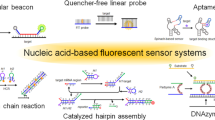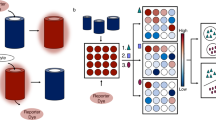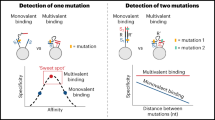Abstract
The secondary structures of nucleic acids have an important influence on their cellular functions but can be difficult to identify and classify quickly. Here, we show that an arrayed suite of synthetic hosts and dyes is capable of fluorescence detection of oligonucleotide secondary structures. Multivariate analysis of different fluorescence enhancements—generated using cationic dyes that show affinity for both DNA G-quadruplexes and the synthetic hosts—enables discrimination between G-quadruplex structures of identical length and highly similar topological types. Different G-quadruplexes that display the same folding topology can also be easily differentiated by the number of G-quartets and sequence differences at the 3′ or 5′ ends. The array is capable of both differentiation and classification of the G-quadruplex structures at the same time. This simple non-invasive sensing method does not require the discovery and synthesis of specific G-quadruplex binding ligands, but employs a simple multicomponent approach to ensure wide applicability.

This is a preview of subscription content, access via your institution
Access options
Access Nature and 54 other Nature Portfolio journals
Get Nature+, our best-value online-access subscription
$29.99 / 30 days
cancel any time
Subscribe to this journal
Receive 12 print issues and online access
$259.00 per year
only $21.58 per issue
Buy this article
- Purchase on Springer Link
- Instant access to full article PDF
Prices may be subject to local taxes which are calculated during checkout





Similar content being viewed by others
Data availability
The raw data corresponding to the supplementary figures are available as Supplementary Data. Source data are provided with this paper.
References
Belmont, P., Constant, J.-F. & Demeunynck, M. Nucleic acid conformation diversity: from structure to function and regulation. Chem. Soc. Rev. 30, 70–81 (2001).
Balasubramanian, S., Hurley, L. H. & Neidle, S. Targeting G-quadruplexes in gene promoters: a novel anticancer strategy? Nat. Rev. Drug Discovery 10, 261–275 (2011).
Seeman, N. C. & Sleiman, H. F. DNA nanotechnology. Nat. Rev. Mater. 3, 17068 (2017).
Pinheiro, A. V., Han, D., Shih, W. M. & Yan, H. Challenges and opportunities for structural DNA nanotechnology. Nat. Nanotechnol. 6, 763–772 (2011).
Jaeger, L. & Chworos, A. The architectonics of programmable RNA and DNA nanostructures. Curr. Opin. Struct. Biol. 16, 531–543 (2006).
Winnerdy, F. R. et al. NMR solution and X-ray crystal structures of a DNA containing both right-and left-handed parallel-stranded G-quadruplexes. Nucleic Acids Res. 47, 8272–8281 (2019).
Salgado, G. F., Cazenave, C., Kerkour, A. & Mergny, J.-L. G-quadruplex DNA and ligand interaction in living cells using NMR spectroscopy. Chem. Sci. 6, 3314–3320 (2015).
del Villar-Guerra, R., Trent, J. O. & Chaires, J. B. G-quadruplex secondary structure obtained from circular dichroism spectroscopy. Angew. Chem. Int. Ed. 57, 7171–7175 (2018).
Eubanks, C. S., Forte, J. E., Kapral, G. J. & Hargrove, A. E. Small molecule-based pattern recognition to classify RNA structure. J. Am. Chem. Soc. 139, 409–416 (2017).
You, L., Zha, D. & Anslyn, E. V. Recent advances in supramolecular analytical chemistry using optical sensing. Chem. Rev. 115, 7840–7892 (2015).
Eubanks, C. S. et al. Visualizing RNA conformational changes via pattern recognition of RNA by small molecules. J. Am. Chem. Soc. 141, 5692–5698 (2019).
Stewart, S., Ivy, M. A. & Anslyn, E. V. The use of principal component analysis and discriminant analysis in differential sensing routines. Chem. Soc. Rev. 43, 70–84 (2014).
del Villar-Guerra, R., Gray, R. D., Trent, J. O. & Chaires, J. B. A rapid fluorescent indicator displacement assay and principal component/cluster data analysis for determination of ligand–nucleic acid structural selectivity. Nucleic Acids Res. 46, e41 (2018).
Huppert, J. L. Four-stranded nucleic acids: structure, function and targeting of G-quadruplexes. Chem. Soc. Rev. 37, 1375–1384 (2008).
Bochman, M. L., Paeschke, K. & Zakian, V. A. DNA secondary structures: stability and function of G-quadruplex structures. Nat. Rev. Genet. 13, 770–780 (2012).
Burge, S. et al. sequence, topology and structure. Nucleic Acids Res. 34, 5402–5415 (2006).
Dolinnaya, N. G., Ogloblina, A. M. & Yakubovskaya, M. G. Structure, properties, and biological relevance of the DNA and RNA G-quadruplexes: Overview 50 years after their discovery. Biochemistry 81, 1602–1649 (2016).
Kwok, C. K. & Merrick, C. J. G-quadruplexes: prediction, characterization, and biological application. Trends Biotechnol. 35, 997–1013 (2017).
Puig Lombardi, E. & Londoño-Vallejo, A. A guide to computational methods for G-quadruplex prediction. Nucleic Acids Res. 48, 1–15 (2020).
Zuffo, M. et al. More is not always better: finding the right trade-off between affinity and selectivity of a G-quadruplex ligand. Nucleic Acids Res. 46, e115 (2018).
Felsenstein, K. M. et al. Small molecule microarrays enable the identification of a selective, quadruplex-binding inhibitor of MYC expression. ACS Chem. Biol. 11, 139–148 (2016).
Pinalli, R., Pedrini, A. & Dalcanale, E. Biochemical sensing with macrocyclic receptors. Chem. Soc. Rev. 47, 7006–7026 (2018).
Dsouza, R. N., Hennig, A. & Nau, W. M. Supramolecular tandem enzyme assays. Chem. Eur. J. 18, 3444–3459 (2012).
Hennig, A., Bakirci, H. & Nau, W. M. Label-free continuous enzyme assays with macrocycle-fluorescent dye complexes. Nat. Methods 4, 629–632 (2007).
Peacor, B. C., Ramsay, C. M. & Waters, M. L. Fluorogenic sensor platform for the histone code using receptors from dynamic combinatorial libraries. Chem. Sci. 8, 1422–1428 (2017).
Minaker, S. A., Daze, K. D., Ma, M. C. F. & Hof, F. Antibody-free reading of the histone code using a simple chemical sensor array. J. Am. Chem. Soc. 134, 11674–11680 (2012).
Florea, M. & Nau, W. M. Implementation of anion-receptor macrocycles in supramolecular tandem assays for enzymes involving nucleotides as substrates, products, and cofactors. Org. Biomol. Chem. 8, 1033–1039 (2010).
Liu, Y. et al. Selective heavy element sensing with a simple host–guest fluorescent array. Anal. Chem. 89, 11113–11121 (2017).
Gill, A. D. et al. Sensing of citrulline modifications in histone peptides by deep cavitand hosts. Chem. Commun. 55, 13259–13262 (2019).
Murat, P., Singh, Y. & Defrancq, E. Methods for investigating G-quadruplex DNA/ligand interactions. Chem. Soc. Rev. 40, 5293–5307 (2011).
Biros, S. M., Ullrich, E. C., Hof, F., Trembleau, L. & Rebek, J. Kinetically stable complexes in water: the role of hydration and hydrophobicity. J. Am. Chem. Soc. 126, 2870–2876 (2004).
Liu, Y. et al. Site-selective sensing of histone methylation enzyme activity via an arrayed supramolecular tandem assay. J. Am. Chem. Soc. 139, 10964–10967 (2017).
Liu, Y. et al. Selective sensing of phosphorylated peptides and monitoring kinase and phosphatase activity with a supramolecular tandem assay. J. Am. Chem. Soc. 140, 13869–13877 (2018).
Mosca, S., Yu, Y. & Rebek, J. Preparative scale and convenient synthesis of a water-soluble, deep cavitand. Nat. Protoc. 11, 1371–1387 (2016).
Pinalli, R. et al. The origin of selectivity in the complexation of N-methyl amino acids by tetraphosphonate cavitands. J. Am. Chem. Soc. 138, 8569–8580 (2016).
Menozzi, D. et al. Thermodynamics of host–guest interactions between methylpyridinium salts and phosphonate cavitands. Supramol. Chem. 22, 768–775 (2010).
Yang, Q. et al. Verification of specific G-quadruplex structure by using a novel cyanine dye supramolecular assembly: II. The binding characterization with specific intramolecular G-quadruplex and the recognizing mechanism. Nucleic Acids Res. 38, 1022–1033 (2010).
Früh, A. E., Artoni, F., Brighenti, R. & Dalcanale, E. Strain field self-diagnostic Poly(dimethylsiloxane) elastomers. Chem. Mater. 29, 7450–7467 (2017).
Thordarson, P. Determining association constants from titration experiments in supramolecular chemistry. Chem. Soc. Rev. 40, 1305–1323 (2011).
Sengar, A., Heddi, B. & Phan, A. T. Formation of G-quadruplexes in poly-G sequences: structure of a propeller-type parallel-stranded G-quadruplex formed by a G15 stretch. Biochemistry 53, 7718–7723 (2014).
Ambrus, A. et al. Human telomeric sequence forms a hybrid-type intramolecular G-quadruplex structure with mixed parallel/antiparallel strands in potassium solution. Nucleic Acids Res. 34, 2723–2735 (2006).
Acknowledgements
We thank the National Science Foundation (CHE-1707347 to W.Z and R.J.H.) and MIUR (PRIN 20179BJNA2 to E.D.) for funding.
Author information
Authors and Affiliations
Contributions
R.J.H. and W.Z. conceived and designed the experiments and wrote the paper. J.C. performed the arrayed sensing experiments and statistical analysis with help from L.W. and J.L. Chemical synthesis and optical analysis of hosts and dyes were performed by B.L.H., A.D.G, A.F., R.P. and E.D. All authors contributed to manuscript creation and proofreading.
Corresponding authors
Ethics declarations
Competing interests
The authors declare no competing interests.
Additional information
Peer review information Nature Chemistry thanks the anonymous reviewer(s) for their contribution to the peer review of this work.
Publisher’s note Springer Nature remains neutral with regard to jurisdictional claims in published maps and institutional affiliations.
Extended data
Extended Data Fig. 2 Effect of DNA strands on the emission profile of various host–dye complexes.
Comparison between the raw fluorescence response curves (left) and normalized fluorescence response curves (right) corresponding to the emission of DSMI dye in the presence of different DNA strands upon titration of hosts a,b) 1; c,d) 2; e,f) 5, illustrating the effect of the DNA structure on the emission of the various host–guest complexes. [DSMI] = 0.625 μM, [DNA] = 0.1 μM, [host] = 0–8 μM, 10 mM KH2PO4/K2HPO4 buffer, 1 mM EDTA, pH 7.4, Ex/Em = 485 nm/605 nm. The normalization process defines F0 as the emission at [DNA] = 0. Plots a, c, e are extended versions of those shown in Fig. 2. For the full suite of titration plots with all hosts 1–5 and both dyes, see Supplementary Figs. 18 and 19. Error bars represent the standard deviation of 3 repeated measurements.
Extended Data Fig. 3 Discrimination of a suite of 23 G-quadruplex structures.
2D PCA scores plot of the first two principal components (PC) generated from the fluorescence responses of 23 G4 strands to the sensing array. The data is identical to that shown in Fig. 4a, but rather than using the average of 5 repeats for each DNA in PCA, herein each repeat is treated as one individual sample. The first two principal components in total summarize more than 88% of the variation contained in the data, and their scores plot provides a visualization of how the 23 DNA strands are grouped by our array. Ellipses indicate 95% confidence.
Supplementary information
Supplementary Information
Supplementary Figs. 1–40 and Tables 1–3.
Supplementary Data 1
Source data for the figures within the Supplementary Information file.
Source data
Source Data Fig. 1
Fluorescence response curve source data.
Source Data Fig. 3
Array-based sensing and statistical source data.
Source Data Fig. 4
Array-based sensing and statistical source data.
Source Data Fig. 5
Array-based sensing and statistical source data.
Source Data Extended Data Fig. 3
Statistical source data.
Rights and permissions
About this article
Cite this article
Chen, J., Hickey, B.L., Wang, L. et al. Selective discrimination and classification of G-quadruplex structures with a host–guest sensing array. Nat. Chem. 13, 488–495 (2021). https://doi.org/10.1038/s41557-021-00647-9
Received:
Accepted:
Published:
Issue Date:
DOI: https://doi.org/10.1038/s41557-021-00647-9
This article is cited by
-
Optical Chemosensors Synthesis and Appplication for Trace Level Metal Ions Detection in Aqueous Media: A Review
Journal of Fluorescence (2024)
-
Development of RNA G-quadruplex (rG4)-targeting l-RNA aptamers by rG4-SELEX
Nature Protocols (2022)
-
A facile way to construct sensor array library via supramolecular chemistry for discriminating complex systems
Nature Communications (2022)
-
Lanthanide-DNA supramolecular hydrogels with tunable and responsive luminescence
Science China Technological Sciences (2022)
-
Host-Guest Sensor Array for Discriminating G-Quadruplexes
Chemical Research in Chinese Universities (2021)



